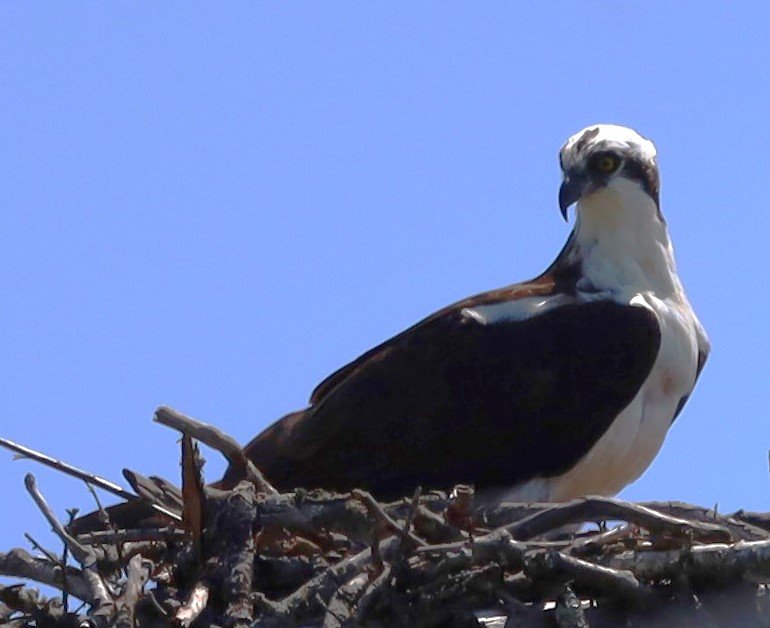I finally meet my kestrel
One of a pair of kestrels hunting a hay field in Northern Ontario earlier this month. All photos, unless otherwise noted, © John Degen
Maybe a decade ago, when sweeping the terrace outside our condo in Toronto, I came upon a fairly fresh bird carcass in the little well created by where our glass balcony front dips below the concrete deck. Having never seen anything larger than a house sparrow in our seventh-floor container garden, I was impressed by the bird’s size. Larger than a kingbird, smaller than a crow… it was an American Kestrel (Falco sparverius), North America’s smallest falcon.
While our glass frontage has a smoky glaze and is supposedly bird-friendly, this little creature did not get the memo, and had clearly plowed headlong into the glass while chasing prey (perhaps one of those aforementioned house sparrows — in some areas, the kestrel is called a Sparrow Hawk). It dropped out of sight into a perfectly kestrel-sized concrete and glass coffin, and was slowly being covered by blowing autumn leaves. With rubber gloves on, I extracted the poor thing, bagged it, and gave it the best bird funeral I could manage in an urban environment. But before we parted company, I had a good long look.
This magnificent kestrel capture is © Alex Shipherd / Macauley Library
Kestrels are beautifully patterned and coloured, with gray/blue and tan sections, bold cheek stripes, and a speckled breast plate. I’d never seen one up close before, and it was entrancing. I can say with confidence that has been the one and only bird-strike I’ve experienced in 14 years of living here, but I’ve never gotten over it. And once I started birding in earnest, the American Kestrel was an immediate target species for me. I wanted to see one flying and hunting. I needed a live spectacle to soften the memory of the one who didn’t make it.
My kestrels shared this prey-filled meadow with an American Crow (Corvus brachyrhynchos) and an Eastern Kingbird (Tyrannus tyrannus).
Out for an evening birding drive recently in the farmland around my northern home, I finally got my wish. A pair of kestrels were hunting a once-mown hay field from a perch on overhead wires. The late day sun deepened their colour patterns, and made them instantly recognizable, even from a distance. I pulled to the narrow shoulder, checked my surroundings and started walking toward them. Thus began a game of kestrel and mouse that gave me a good long walk. I’d stop when I thought I was close enough for a good shot, raise my camera, peer through the lens and… they were gone. The little falcons swooped low over the field, circled wide and came back to the wire a hundred or so meters further down the road.
Walk, stop, raise camera, swear.
Walk, stop, raise camera, swear.
This went on for a while.
The best I could manage of these little tricksters while on their track.
Worried I was maybe stressing the birds away from their dinner, I took the long trudge back to my car and tried a different approach, driving casually down the road as though I was just heading home. One of the kestrels took off again, but the other stayed. I managed to stop and take a short series of the wary little creature leaning from my driver-side window, and then quickly left it to hunt.
The massive range of the American Kestrel. The north shore of Lake Huron, where I spotted them, is right in the middle of their breeding grounds. Thanks to Cornell University for the range map.
Kestrels have an expansive range in the Americas, but their numbers are in a distressing decline. The north shore of Lake Huron, where I saw my kestrels, is a comfortable, wild, breeding territory, but the fierce little predators head south for the winter. Scientists speculate that loss of habitat and predation from larger raptors have contributed to a 50% decline in kestrel numbers over the last half-century. What’s more, this small falcon has responded to its population stress by becoming even smaller. According to Living Bird magazine from the Cornell Lab of Ornithology, “over time, kestrels have lost both weight and wing chord (a standard measure of bird wing size). In several regions, the body shrinkage is considerable, with the weight and size loss particularly acute in places where the population decline is most severe.” Read Cornell Senior Lecturer Lauren Chambliss’s full article on the shrinking kestrel here.
And you can help protect and encourage kestrel populations by building and installing a kestrel nest box on your property. Plans and info here, thanks to the Cornell Lab of Ornithology’s NestWatch project.
Effortlessly at height hangs his still eye.
His wings hold all creation in a weightless quiet
Steady as a hallucination in the streaming air.
— The Hawk in the Rain, Ted Hughes

































